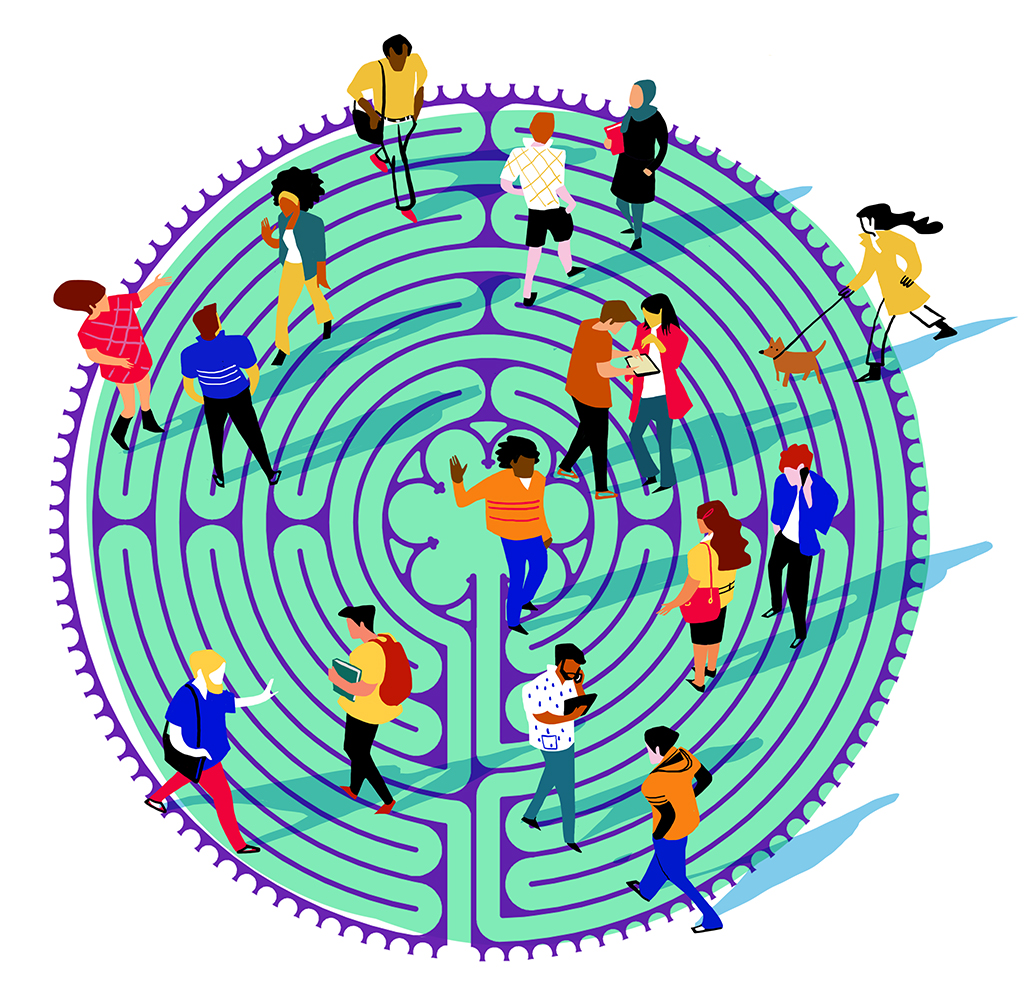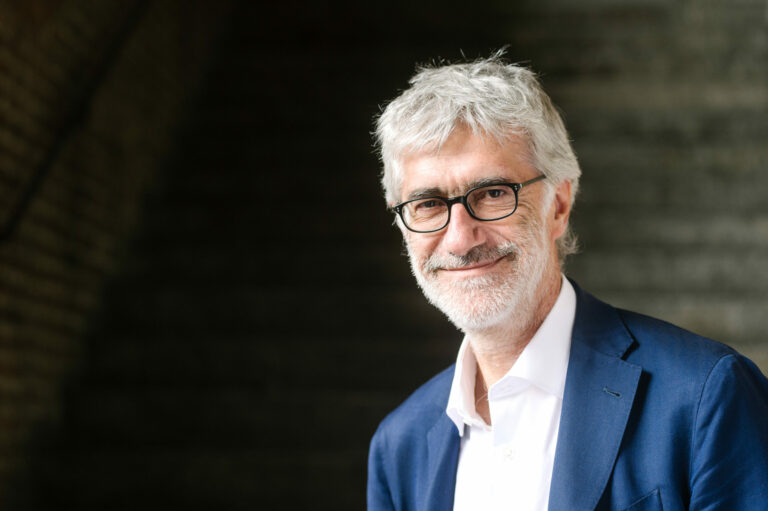Trends
Collective intelligence in a multilingual context
Luca De Biase defines a framework for what a collective intelligence entails and addresses the crucial role of machines in a multicultural and multilingual context.
What is a blade runner? Who are the replicants, and who created them? Can spaceships be stolen? The cryptic introduction to Ridley Scott’s 1982 sci-fi masterpiece Blade Runner doesn’t give us an answer. Whoever chose the words focused their attention on the story, merely alluding to the context. But devotees of the movie know that the appeal of the story is in the reconstruction of a possible future; it becomes foundational to a world that is comparable to what viewers are used to. And one of the essential differences is linguistic. Harrison Ford’s mission takes place in a city in which several languages are spoken. Everyone is used to it, and they try to understand each other using various techniques based on experience: they know that in order to fully live their daily lives, they must understand each other. The narrative depicts a world where the multilingual dimension is normal. Unlike today’s, in which the norm is monolingual. The association between linguistic diversity and difficulty in understanding is entirely cultural. It is related perhaps to the 19th-century history of identification between states and nations. But it is certainly not definitive. A multilingual normality is possible. This article explores the possibility of multilingual collective intelligence: it searches for the pre-conditions and hypothesizes its design.
1. A multilingual world in general, words can perhaps shape concepts, but certainly the specific term “artificial intelligence” has triggered the concerns of those who see it in opposition to “natural intelligence,” to the point of thinking it could replace humans. The misunderstanding is twofold: firstly, artificial intelligence is not an entity in itself, but is entirely an expression of the intelligence of humans. Secondly, human intelligence has little that is “natural,” since it is inherently rather “cultural” in nature, given its sedimentation over millennia of human experience, techniques, beliefs, and actions aimed at modifying and taming nature itself, among other things. Human intelligence is the product of a very long history of collaborative endeavor. Thus it is far more worthwhile to address the relationship between diverse forms of individual and collective intelligence; moreover, both augmented and modified by the introduction of connectivity tools, digital storage and automatic processing. This is certainly a very complex and intense argument to which we can refer and add a generative and complex dimension: what happens to collective intelligence in a multilingual context?
There are not many questions less abstract than this one. Europeans, Indians, and a great many other peoples who share a common political system are apparently divided into very different language groups: but is this a strength or a weakness? Perhaps this question is becoming less and less relevant, and this for two reasons:
1. The social reshuffling that is taking place in all the territories of the world with strong migratory trends contextually generates multilingual scenarios where the previous conditions were more homogeneous. In the context of the difficulties this entails, can we at least perceive an enrichment of destination cities due to the multiplication of languages and cultures found there?
2. Whatever the fate of globalization as it was construed until a few years ago, the community of humans as a whole – which is obviously multilingual – is being called upon to make the most important decisions in its history in order to be able to deal with the enormous challenges that unite it, from the climate emergency to social polarization.
To increase the chances of overcoming those challenges, there is an effort, on the one hand, to improve the machines that humans use to operate, and on the other, an insistence on improving the education of humans. Alex Sandy Pentland suggests that it is time to design human-machine systems in a better way. “I think we should build a society in which our tools can be harnessed both to make us smarter and also to connect more deeply with each other and the planet. First and foremost, humans are builders and users of tools, and building tools that make us smarter and unite us is a very natural human goal. We should focus on how to best integrate our computing tools into our social, economic, political, and cultural systems rather than searching for an artificial intelligence that is separate from humanity.”
(Alex Sandy Pentland, “Società computazionali,” postfazione a Cosimo Accoto, Il mondo in sintesi, Egea 2022)
We cannot understand collective intelligence by studying the individual intelligence of the people involved in the groups under consideration. Likewise, we cannot consider artificial intelligence a separate entity from the human process involved
In this regard, we can hypothesize that forms of collective intelligence can emerge in multilingual human groups if they are designed as human-machine systems with balanced components, sensitive to feedback and consistent with the preconditions that science has defined as capable of enabling this class of phenomenon.
The meaning of such a hypothesis can be investigated by reviewing the available knowledge on forms of collective intelligence and applying it to the design of human-machine systems for multilingual groups.

2. Complex systems first of all, a clarification is needed. The phenomena being investigated cannot be understood if we address them with a linear approach. We are addressing complex systems in every sense here, which means that research cannot dwell on the various individual elements of the system. We cannot understand collective intelligence by studying the individual intelligence of the people involved in the groups under consideration. Likewise, we cannot consider artificial intelligence a separate entity from the human process involved. There will be no simple recipes for solving the problem of language multiplicity or individual variables that will explain the end result by themselves.
In complex systems, individual components matter less than the set of relationships between them. Yaneer Bar-Yam, president of the New England Complex Systems Institute, wrote: “Complex Systems is a new approach to science, which studies how relationships between parts give rise to the collective behaviors of a system and how the system interacts and forms relationships with its environment” (Yaneer Bar-Yam, Making Things Work. Solving Complex Problems in a Complex World, Necsi Knowledge Press 2004, p. 24.)
Yaneer Bar-Yam developed the mathematics of complex systems certainly not to contemplate their dynamics but to obtain concrete application results. “Social systems arise (in part) out of relationships between people, the brain’s behaviors result from relationships between neurons, molecules are formed out of relation- ships between atoms, and weather patterns are formed because of relationships between air flows. Social systems, the human brain, molecules, and weather patterns are examples of complex systems.”
Indeed, a brain is a network of nerve cells that self-organize to manage the needs of its host body, relate it to the outside world, generate memories and thoughts, enable communication and decision-making, and so on. But a network of human brains also functions in a similar fashion: such a network can self-organize to manage the needs of the social body that hosts them, relating the network to the outside world, generating memories and thoughts, enabling communication and decision-making, and so on. In the infinite degrees of evolution from the individual to the collective dimension, the complex system that serves to gather information and process it and thus guide action toward good results is what is often called intelligence. Of course, this is a relatively pragmatic conception of intelligence. More specifically, we can distinguish between different types of intelligence. The main distinction is between specialized intelligence (“the ability to achieve specific goals effectively in a given environment”) and general intelligence (“the ability to achieve a wide range of different goals effectively in different environments”). In addition, according to some scholars, there are multiple intelligences: musical, physical, interpersonal, and so on.
(Howard Gardner, Frames of mind: theory of multiple intelligences, Basic Books 1983. And Howard Gardner, Multiple intelligences: new horizons, Basic Books 2006.)
3. Collective intelligence Tom Malone founded the Center for Collective Intelligence at MIT. His research was driven by a clear question: does collective intelligence exist? Malone defines a supermind as “a group of individuals acting together in ways that seem intelligent.” Therefore, collective intelligence is “the result of groups of individuals acting together in ways that seem intelligent.” The approach to answering the question about the existence of collective intelligence was “experimental”: if, by testing a large number of groups of people for intelligence, it was found that it some groups could be observed as turning out intelligent regardless of the average intelligence of the group members or the intelligence of the most intelligent group member, then it could be said that collective intelligence existed. Malone and his colleagues thus created a series of tests suitable for assessing the general intelligence of groups and found that, indeed, there was a possibility of seeing collective intelligence at work with results that did not depend on the average or maximum intelligence of group members, producing a paper that was accepted for publication by “Science”. (Anita Williams Woolley, Christopher F. Chabris, Alex Pentland, Nada Hashmi, and Thomas W. Malone, “Evidence for a Collective Intelligence Factor in the Performance of Human Groups,” Science, Sep 30, 2010, Vol. 330, Issue 6004, pp. 686-688: https://www.science.org/doi/10.1126/science.1193147)
Malone and colleagues found that neither the average intelligence of group members nor the intelligence of the smartest group member were significantly correlated with group intelligence.
In other words, putting together a group of highly intelligent people is no guarantee of having a highly intelligent group. In addition, the scholars were able to discard other variables, such as satisfaction with belonging to the group, people’s motivation to make the group work well, and the sense of comfort that members felt by participating in group activities. These variables were unrelated to the outcome of the collective intelligence tests. “But we did find three factors that were significant. The first was the average social perceptiveness of the group members.” If people have a good level of social intelligence, if they can understand the mental state of others, the group is likely to be more intelligent. “The second important factor we found was the degree to which group members participated about equally in conversation. When one or two people dominated the conversation, the group was, on average, less intelligent than when participation was more evenly distributed. Finally, we found that a group’s collective intelligence was significantly correlated with the proportion of women in the group. Groups with a higher proportion of women were more intelligent”. (Malone, Superminds, pp. 34-35.)
Continuing the research, Malone and colleagues found that group intelligence is also highly correlated with diversity of cognitive style. “We looked at diversity of cognitive style – differences in how people habitually think about the world. Based on previous research on this topic, we considered people with three different cognitive styles: verbalizers, object visualizers, and spatial visualizers.
“The ability to achieve specific goals effectively in a given environment”
Specialized Intelligence
“The ability to achieve a wide range of different goals effectively in different environments”
General Intelligence
Verbalizers are good at reasoning with words; object visualizers are good at dealing with the overall properties of images (like paintings); spatial visualizers are good at analyzing images part by part (as in an architectural blueprint). Loosely speaking, these three cognitive styles are typical of students in the humanities, the visual arts, and engineering, respectively”.
Collective intelligence is high if cognitive diversity is average: “When we analyzed the collective intelligence of groups with various mixes of these cognitive styles, we found that the most collectively intelligent groups were those with an intermediate level of cognitive diversity. In other words, groups where the members had very different cognitive styles weren’t as intelligent, perhaps because they couldn’t communicate effectively with one another. And groups where all the members had the same cognitive style weren’t as intelligent either, perhaps because they didn’t have the range of skills needed to do the different tasks. The best combination seemed to be groups in the middle, perhaps because there was enough commonality to communicate effectively and enough diversity to solve a range of different problems.”
In other words, a collective intelligence needs members capable of understanding the mood of others, able to participate in conversations in a balanced and respectful manner of others, with a good deal of cognitive diversity as long as it does not reduce the members’ ability to communicate with each other. In addition, groups with more women than men, as long as they are not composed only of women, are more likely to manifest signs of collective intelligence.
4. Cognitive diversity and language Malone asserts that cognitive diversity is important in explaining group intelligence as long as it does not come at the expense of the quality of communication among group members. What affects cognitive diversity and communication simultaneously? Well, that’s easily answered: human languages have precisely both of these capabilities.
The relationship between language and thinking is one of the great themes of investigation in all the sciences and disciplines concerned with cognition. We cannot report on this kind of investigation here on an even remotely complete map, but simply offer a reference. Indeed, George Lakoff’s metaphors constitute a clear theoretical connection between the body, thought and language. (George Lakoff and Mark Johnson, Metaphors we live by, University of Chicago Press 1980)
But there is a great deal of empirical research that poses the problem in a more concrete way. For example, thanks to the empirical work of Lera Boroditsky, a researcher at the University of California, San Diego, we know that language shapes thinking. In one of her early research papers, Boroditsky asked, “Does the language you speak affect how you think about the world?” (Lera Boroditsky, “Does Language Shape Thought?: Mandarin and English Speakers’ Conceptions of Time” Cognitive Psychology Volume 43, Issue 1, August 2001, Pages 1-22 – https://doi.org/10.1006/ cogp.2001.0748).

World Wide Wisdom
Research Report 2023
It is possibile to improve the understanding between people that speak different languages and thus improve their ability to do things together in a smarter way? Can it be that a multilingual group is able to do better things? In order to answer to these questions we need to take into account how groups of people think and work together and how their collaboration can be improved.
Get Your Copy Now!“This question is addressed using three examples. Firstly, English and Mandarin address time differently: English predominantly addresses time as if it were horizontal, while Mandarin also commonly describes time as vertical. This difference between the two languages is reflected in the way their speakers think about time. In one study, Mandarin speakers tended to think about time vertically even when they were thinking through English (Mandarin speakers were faster to confirm that March comes earlier than April if they had just seen a vertical array of objects than if they had just seen a horizontal array, and the reverse was true for English speakers). Another study showed that the extent to which Mandarin–English bilinguals think about time vertically is related to how old they were when they first began to learn English. In another experiment, native English speakers were taught to discuss time using vertical spatial terms in a manner similar to Mandarin. On a subsequent test, this group of English speakers showed the same bias to thinking about time vertically as was observed with the Mandarin speakers. It was concluded that (1) language is a powerful tool in shaping thought about abstract domains, and (2) a person’s native language plays an important role in shaping habitual thought (e.g., how one tends to think about time) but does not entirely determine one’s thinking.” Continuing her research over the next decade and publishing a significant number of articles, Boroditsky generalized her conclusions: “For a long time, the idea that language might shape thought was considered at best untestable and more often simply wrong. Research in my labs at Stanford University and at MIT has helped reopen this question.
We have collected data around the world: from China, Greece, Chile, Indonesia, Russia, and Aboriginal Australia. What we have learned is that people who speak different languages do indeed think differently and that even flukes of grammar can profoundly affect how we see the world. Language is a uniquely human gift, central to our experience of being human. Appreciating its role in constructing our mental lives brings us one step closer to understanding the very nature of humanity.”
(Lera Boroditsky, “How does our language shape the way we think,” Edge 2009 – https://my.uopeople.edu/ pluginfile.php/57436/mod_book/chapter/38890/BUS2207U4Text1.pdf)
But this is only one of the lines of research that enable us to understand how language contributes to shaping thought, while in turn obviously being the result of the evolution of social experience that sediments in culture. Richard Nisbett’s research on the differences between mental structures developed in the West and Asia led him to recognize language both as the demonstration of his hypotheses and as the process that perpetuates those differences. (Richard Nisbett, The geography of thought. How Asians and Westerners think differently… and why, Free Press 2003)

“The concern with the abstraction characteristic of ancient Greek philosophy has no counterpart in Chinese philosophy. Chinese philosophers quite explicitly favored the most concrete impressions in understanding the world. In fact, the Chinese language itself is remarkably concrete. There is no word for “size,” for example. If you want to fit someone for shoes, you ask them for the ‘big-small’ of their feet. There is no suffix equivalent to “ness” in Chinese. So there is no ‘whiteness’ – only the white of the swan and the white of the snow. The Chinese are disinclined to use precisely defined terms or categories in any arena, but instead use ex- pressive, metaphoric language”. In general, Western thought focuses on individuals, individual objects, the parts that make them up and the categories that describe them: whereas in Chi- nese thought, says Nisbett, the focus is on the relationships between the parts. In Western language, as in children’s language education, the names of things are very important. In Asian languages in general, on the other hand, verbs are more important. And while Western thought is bent on desiring freedom, Chinese thought is geared toward the pursuit of harmony. The relationship between languages and the mental attitude toward relating to others is a significant aspect of Erin Meyer’s research. (Erin Meyer, The culture map. Decoding how people think, lead and get things done across cultures, PublicAffairs 2014)
One of the most complex issues highlighted by Meyer is that there are cultures in which etiquette requires leaving much to the implicit, and other cultures that instead explicate everything: the relationship between said and unsaid has important consequences for communication and the choice of words used in social relationships. In cross-cultural relationships, it is necessary to learn to understand implied meanings and not just what is said outright. When people who are accustomed to expressing themselves in a manner that anchors much of their communication to the implicit encounter other people whose culture leads them to behave in the opposite way, the plain translation of the latter to the former, however correct, can be interpreted as rude, while the translation of the former to the latter may even be unintelligible.
It is clear that simply translating words from one language to another may be insufficient for understanding in interlingual communication. Indeed, the expertise of professional linguists, as described by Nataly Kelly and Jost Zetzsche, includes areas that extend well beyond translation. Some linguists address “multilingual intelligence.” (Nataly Kelly and Jost Zetzsche, Found in translation. How language shapes our lives and transforms the world, Perigee Book 2012)
“Media analysts perform many functions, but their job boils down to one main thing: finding out what’s going on in a given place and making sense of it. They track information from a country or region they know intimately (…). And of course they know the language, too (…). In other words, they are expected to translate information not only at the level of ‘what does this say?’ but at the level of ‘what does it mean?’ and perhaps more importantly, when a critical situation arises, ‘what does it really mean?’”.
In all these cases, language – composed of sounds, writings, and images – is the fundamental means of communication and also the locus of cultural sedimentation. The relationship between words, narratives, and contexts forms the basis of the interlinguistic understanding of meanings. But this does not happen only in one direction: language should not be seen only for its presumed function of locking the minds of the people who speak it into one culture and one worldview; it can serve the exact opposite and help people simultaneously experience and internalize different worldviews. And indeed, it does. As David Crystal observes, “Speaking two or more languages is the natural way of life for three-quarters of the human race. There are no official statistics, but with over 6,000 languages co-existing in fewer than 200 countries, it is obvious that an enormous amount of language contact must be taking place; and the inevitable result of languages in contact is multilingualism, which is most commonly found in an individual speaker as bilingualism.” (David Crystal, How language works, Penguin 2006.) For Crystal, bilingualism is the norm, not the exception.
5. Collective intelligence design is “multilingual collective intelligence” possible? In an increasingly interconnected world, it may become a question of strategic perspective. But do the characteristics of collective intelligence change when crossing different linguistic contexts? If the answer were negative, one might think that the same dynamics should operate in a multilingual group as well.
Malone experimented with his test for collective intelligence in several languages: American English, German, and Japanese. In addition, he tested it with groups communicating in different ways: physically present, by voice, by video, and by text only. And he found the same regularities in all cases. The characteristics of groups that manifest collective intelligence, one would say, are similar in different linguistic contexts, and it is hard to see why they should not function similarly in a group in which different languages are spoken.
It is quite likely that the presence of people speaking different languages in a group may foster a measure of cognitive diversity, as long as this does not occur at the expense of communication. The multilingual condition should be valued and not passively suffered. For that matter, the same can be said of other forms of diversity: respect is one thing, but genuine curiosity to learn about the other’s point of view is far more powerful in building a healthy environment for collaboration. If this spirit is lacking, the risk is that the group will break down into subsets of people who congregate by virtue of their similarity, which can even lead to misunderstandings, if not outright conflict.
How do you build a multi-stakeholder, multilingual, multidisciplinary, multicultural group that can at the same time communicate in order to process thoughts that each individual component would have been unable to conceive? Experience shows that the process that fosters this is probably not a spontaneous one. The far more realistic hypothesis is that some form of collaborative design is needed.
Certainly, as Erin Meyer suggests, the effort to overcome linguistic diversity will have to be motivated by the purpose to be achieved: “Effective cross-cultural collaboration can take more time than mono-cultural collaboration and often needs to be managed more closely.” First, it is not necessarily the case that every aspect of collaboration must be led by all participants at every stage of the process. “Second, think carefully about your larger objectives before you mix cultures up. If your goal is innovation or creativity, the more cultural diversity the better, as long as the process is managed carefully. But if your goal is simple speed and efficiency, then monocultural is probably better than multicultural.” (Erin Meyer, The culture map, p. 114)
If the goal is to foster innovation, how can we imagine a method for designing a group that will manifest intelligent behavior? As it turns out, a group is a group if the people in it are in a unifying context. However, a group is also intelligent if its members respect each other, are empathetic, actively listen to each other, are more often women than men, and are relatively diverse, as long as this does not reduce their ability to communicate. This evidently leads to the conclusion that as diversity grows, solutions to improve communication must grow as well. In a multilingual group, this requires an additional intensity in mutual curiosity among group members, who are aware of their cognitive but also cultural diversity, accompanied by communication tools such that they can overcome difficulties and achieve a strong commu- nicative relationship.
“Design thinking” is a method that has now been proven to work in many situations where a group needs to develop an innovation. An evolved version of design thinking should therefore be the goal of those who want to foster the emergence of collective intelligence in multilingual groups. The characteristics of this evolved version of design thinking should evidently focus on the forms of communication. The result of research along these lines will certainly be a mix of solutions, including: a. a skillful use of imagery; b. a significant use of mathematics; c. a means of communication equipped with automatic translation and, in the best cases, with human supervisors; d. a prevalence of at least bilingual people accustomed to cultivating a curiosity for other cultures and learning about the complexity of meanings experienced when moving from one linguistic context to another. The specific goal for which design thinking is applied, by definition, would then add the essential condition that the members of the group share the same goal and perceive the common innovation they are helping to imagine together. A multilingual, multi-stakeholder, multidisciplinary group will not find a way to communicate by default. But it may succeed by design. And the results may be surprisingly intelligent. Who knows what Forrest Gump would have said? “Smart is as smart does.”

Luca De Biase
Editorial Director
Journalist and writer, head of the innovation section at Il Sole 24 Ore. Professor of Knowledge Management at the University of Pisa. Recent books: Innovazione armonica, with Francesco Cicione (Rubettino, 2020), Il lavoro del futuro (Codice, 2018), Come saremo, with Telmo Pievani (Codice, 2016), Homo pluralis (Codice, 2015). Member of the Mission Assembly for Climate-Neutral and Smart Cities, at the European Commission. Co-founder of ItaliaStartup Association. Member of the scientific committee of Symbola, Civica and Pearson Academy. Until January 2021 he has chaired the "Working Group on the phenomenon of hate speech online", established by the Minister of Technological Innovation and Digitization, with the Ministry of Justice and the Department of Publishing at the Presidency of the Council. He has designed and managed La Vita Nòva, a pioneering bi-monthly review for tablets, that has won a Moebius Award, 2011, in Lugano, and a Lovie Award, 2011, in London. His work has been honored with the James W. Carey Award for Outstanding Media Ecology Journalism 2016, by the Media Ecology Association.
Photo Credit: Markus Spiske, Unsplash
Illustrations by: Dr. Colod and Matteo Licci
